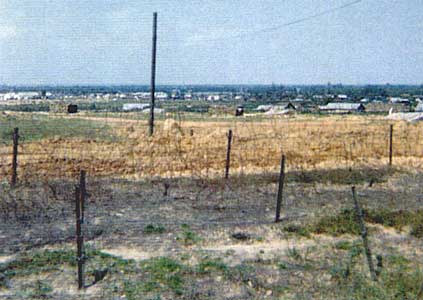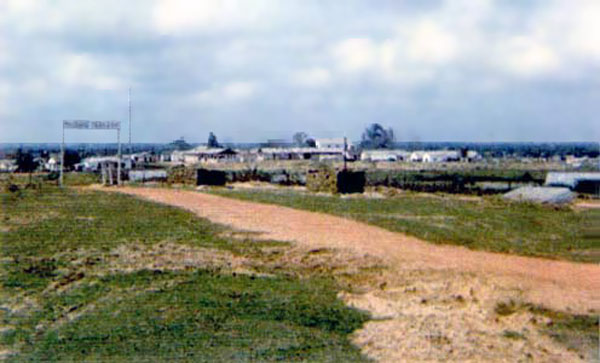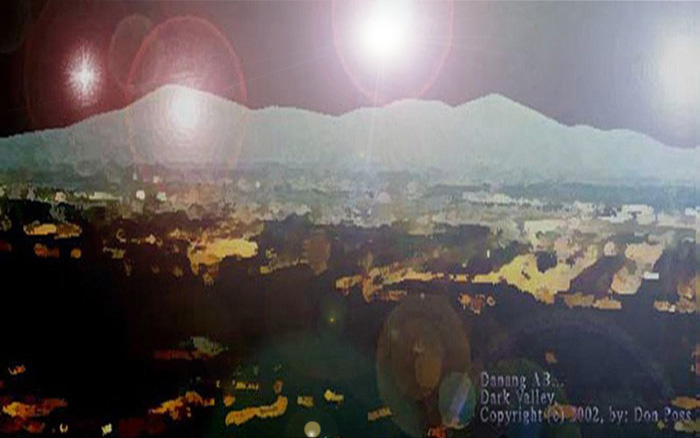Đông Hà Air Field, including the Air Base, Marine Combat Base, units deployed
along the Cua Viet River and South Vietnamese CIDG area received 140
incoming artillery, rocket and mortar rounds fired by the NVA in a stand
off attack during the night on May 18, 1967. The Air Base received some
building damage and some WIA's, but thank God no KIA's. The Marines
took quite a few KIA's, exact number unknown, and WIA's. The NVA walked
their rounds through an area and then waited a few minutes and walked
a second number of rounds through the same area again. Some of the KIA's
had field dressings on them for wounds received in the first sweep of
rounds and they and others were hit again and KIA by the second sweep
of incoming rounds. That morning we searched our area for impact points
and discovered that many of the impact holes had a second hole nearby.
Three Marines were KIA when a rocket landed in the hole they were using
for cover. After seeing the casualties and damage inflicted on the Đông Hà Air Field area by the attack, I believe that we at the Air Base were fortunate
that night.

Red Sky in the Night…NVA
Take Flight!
One of the more interesting aspects
of being a SP on the perimeter at Korat RTAFB during the early
to mid months of 1967 was that I had an excellent view of the war in
northern Quang Tri Province. Đông Hà Air Field was part of four Marine Combat
Bases that formed a quadrilateral extending about 12 miles south from
the eastern DMZ area to the Cua Viet River at Đông Hà Air Field. The quadrilateral
was known as "Leatherneck Square" and included Đông Hà Air Field, Cam
Lo, Con Thien and Gio Lin. Some very heavy fighting took place around
that area as the U.S. Marines and U.S. Army denied the North Vietnamese
Army the opportunity to build up in supplies and troops with the objective
to over run Quang Tri Province. Đông Hà Air Field was receiving alerts for possible
NVA ground assaults. (The NVA finally achieved that objective during
the 1972 Easter Offensive after U.S. Forces had been pulled out of the
war in Quang Tri Province and sent home).
 To
support the build up of troops and supplies, the NVA had mobile Rocket
units that roamed the area and artillery placed in the DMZ that was
dug in and camouflaged. Đông Hà Air Field, at only 12 miles distance, was the
farthest base below the DMZ. The NVA 130mm artillery had a range of
19 miles (almost twice the distance of most of our artillery) that enabled
stand off attacks by the NVA artillery and rockets of all the bases
in the area and also units in the "bush." Additional support
for the NVA was brought in with AAA and SAM SA-2 Missiles that were
a threat to any aircraft flying near the DMZ. I observed a North Vietnamese
SAM SA-2 shoot down one of our aircraft near the DMZ one evening. The
pilot bailed out and survived the attack and was rescued in the DMZ
by a SAR helicopter the next morning. The helicopter was hit four times
during the rescue. With such a concentration of troops, supplies and
armaments in a relatively small area, the NVA must have presented some
inviting targets to our Air Force, Marine and Navy aircraft. I was assigned to bunker post
14 on the northeast perimeter for a night shift in the spring of 1967.
At that time, bunker 14 was a one-man post. An airman from the Sky Spot
radar site came up to my post. Sky Spot directed B-52 Arc Light missions
and jet fighter-bombers to their targets, if known and fixed, within
a 200 mile radius including North Vietnam. The airman said that there
was going to be a bombing mission nearby soon that he would like to
observe from my post. Bunker 14 had the normal slit openings at ground
level, but also had a raised observation sandbag area on top of the
bunker that elevated the SP on post up just enough to give him an excellent
view over the relatively flat terrain east to the coast and north to
the DMZ. The night was clear and the sky
was almost cloudless with brilliant stars hanging over the countryside.
The airman told me to look in an area generally north of our position
and somewhere near the DMZ. He also said that the bombing mission would
be very impressive.The airman and I continued to
look north when a few minutes later there was a large air burst explosion.
It was either one explosion or several so tightly grouped together that
they appeared as one. That was the beginning of the bombing mission
that was being directed by Sky Spot. From that point on, I witnessed
something that I had never seen before. It was difficult to estimate
the altitude of the air burst, but it was at a considerable distance
from the ground. From the point of the air burst, large, red shapes
of something that was neither solid nor liquid started to spread out
and form into dozens of glowing reddish globules (for want of a better
word) of varying sizes and shapes. The glowing globules seemed at first
to be suspended in the air, but then slowly they began to descend to
the earth.It seemed to take the globules
some time before they started impacting. As the first of the globules
touched down there were large explosions on the ground. As each following
globule touched down there would often be tremendous explosions that
would cause other explosions to ignite. Whatever the target was that
Sky Spot was directing the aircraft to hit it was receiving some devastating
blows by the incendiary weapon. The airman from Sky Spot and I sat there
on top of the bunker slack jawed by the experience. As the last of the glowing red
globules struck their targets on the ground I saw numerous fires burning.
Every now and then one of those fires would touch off another massive
explosion. The fires and secondary explosions continued for some time
after the initial bomb drop. The NVA on the ground near that bomb run
had to be experiencing hell on earth that night. The target may have
been a large concentration either of fuel, rockets, artillery or maybe
a SAM site or SAM missiles. I don't know whether one aircraft or several
aircraft were involved in that bombing mission or what the target was
that night. However, it looked like serious damage had been inflicted
from all of the explosions we saw. The Sky Spot airman and I continued
to watch the fires burning in the distance for some time. That was a one-time experience
for me, one of many different experiences that the war in Nam has so
vividly imprinted in my memories.
To
support the build up of troops and supplies, the NVA had mobile Rocket
units that roamed the area and artillery placed in the DMZ that was
dug in and camouflaged. Đông Hà Air Field, at only 12 miles distance, was the
farthest base below the DMZ. The NVA 130mm artillery had a range of
19 miles (almost twice the distance of most of our artillery) that enabled
stand off attacks by the NVA artillery and rockets of all the bases
in the area and also units in the "bush." Additional support
for the NVA was brought in with AAA and SAM SA-2 Missiles that were
a threat to any aircraft flying near the DMZ. I observed a North Vietnamese
SAM SA-2 shoot down one of our aircraft near the DMZ one evening. The
pilot bailed out and survived the attack and was rescued in the DMZ
by a SAR helicopter the next morning. The helicopter was hit four times
during the rescue. With such a concentration of troops, supplies and
armaments in a relatively small area, the NVA must have presented some
inviting targets to our Air Force, Marine and Navy aircraft. I was assigned to bunker post
14 on the northeast perimeter for a night shift in the spring of 1967.
At that time, bunker 14 was a one-man post. An airman from the Sky Spot
radar site came up to my post. Sky Spot directed B-52 Arc Light missions
and jet fighter-bombers to their targets, if known and fixed, within
a 200 mile radius including North Vietnam. The airman said that there
was going to be a bombing mission nearby soon that he would like to
observe from my post. Bunker 14 had the normal slit openings at ground
level, but also had a raised observation sandbag area on top of the
bunker that elevated the SP on post up just enough to give him an excellent
view over the relatively flat terrain east to the coast and north to
the DMZ. The night was clear and the sky
was almost cloudless with brilliant stars hanging over the countryside.
The airman told me to look in an area generally north of our position
and somewhere near the DMZ. He also said that the bombing mission would
be very impressive.The airman and I continued to
look north when a few minutes later there was a large air burst explosion.
It was either one explosion or several so tightly grouped together that
they appeared as one. That was the beginning of the bombing mission
that was being directed by Sky Spot. From that point on, I witnessed
something that I had never seen before. It was difficult to estimate
the altitude of the air burst, but it was at a considerable distance
from the ground. From the point of the air burst, large, red shapes
of something that was neither solid nor liquid started to spread out
and form into dozens of glowing reddish globules (for want of a better
word) of varying sizes and shapes. The glowing globules seemed at first
to be suspended in the air, but then slowly they began to descend to
the earth.It seemed to take the globules
some time before they started impacting. As the first of the globules
touched down there were large explosions on the ground. As each following
globule touched down there would often be tremendous explosions that
would cause other explosions to ignite. Whatever the target was that
Sky Spot was directing the aircraft to hit it was receiving some devastating
blows by the incendiary weapon. The airman from Sky Spot and I sat there
on top of the bunker slack jawed by the experience. As the last of the glowing red
globules struck their targets on the ground I saw numerous fires burning.
Every now and then one of those fires would touch off another massive
explosion. The fires and secondary explosions continued for some time
after the initial bomb drop. The NVA on the ground near that bomb run
had to be experiencing hell on earth that night. The target may have
been a large concentration either of fuel, rockets, artillery or maybe
a SAM site or SAM missiles. I don't know whether one aircraft or several
aircraft were involved in that bombing mission or what the target was
that night. However, it looked like serious damage had been inflicted
from all of the explosions we saw. The Sky Spot airman and I continued
to watch the fires burning in the distance for some time. That was a one-time experience
for me, one of many different experiences that the war in Nam has so
vividly imprinted in my memories.
Terry Sandman
366 SPS, Đà Nàng AB
DET-1, 620 TCS
Đông Hà Air Field Air Base, RVN
1966-1967

